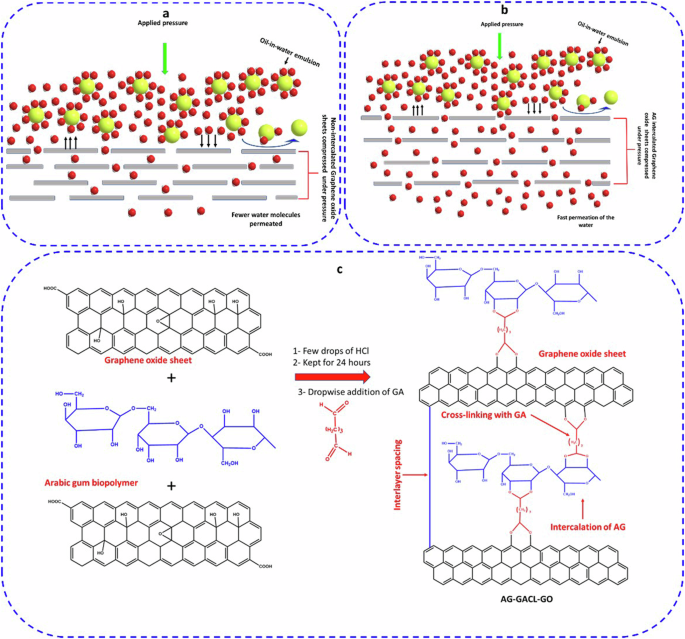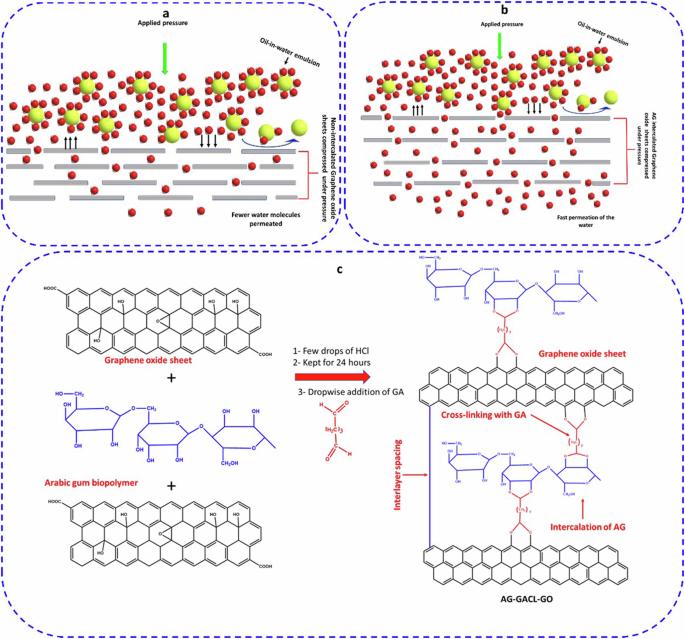Experimental and theoretical assessment of bioinspired next-generation intercalated graphene oxide-based ceramic membranes for oil-in-water emulsion separation
IF 10.4
1区 工程技术
Q1 ENGINEERING, CHEMICAL
引用次数: 0
Abstract
2D graphene oxide (GO) membranes are gaining prominence for water reclamation from oily wastewater. Unresolved challenges include low membrane permeance from tight sheets and fouling during separation. In this work, a bioinspired Arabic gum (AG) was used as an intercalated agent with the help of glutaraldehyde to improve the GO membranes’ permeation and fouling resistance. The 2D-laminated separating layer is crafted through a self-assembling innovative approach utilizing pressurized dead-end assembly. The Arabic gum intercalated graphene oxide-modified ceramic membrane (AGIGO-CM) appeared superhydrophilic and underwater (UW) superoleophobic with a UW oil contact angle (UWOCA) of 156.1 ± 1.2°. The membrane prepared with 1 mg of AGIGO (AGIGO-1-CM) offers a flux of 17 times higher than pristine graphene oxide (p-GO) while maintaining a separation efficiency of >99% during the separation of the oil-in-water emulsions. Molecular dynamics (MD) simulations showed AG intercalation expanding the interlayer distance by up to 20 Å, with AGIGO having a higher fractional free volume (FFV) of 0.986 compared to p-GO’s 0.599. AGIGO-CM displayed lower interfacial formation energy (EIFE) of −1865.2 kcal/mol versus −765.5 kcal/mol for p-GO, indicating easier separation. It is further supported by the substantial interfacial thickness of 148 Å for AGIGO-CM compared to 53.0 Å for the p-GO membranes. AGIGO-CM showed minimal fouling, retaining >99% separation efficiency for 6 h. Compared to p-GO-CM, AGIGO-CM flux decreased by only 17.84% versus 44.72%. AGIGO-CM exhibited stability even in acidic and basic environments, showcasing its potential for high performance.


用于水包油型乳液分离的生物启发下一代插层氧化石墨烯基陶瓷膜的实验和理论评估
二维氧化石墨烯(GO)膜在从含油废水中回收水资源方面的作用日益突出。尚未解决的难题包括膜的渗透率低,膜的片层过厚,以及分离过程中的污垢问题。在这项工作中,一种生物启发的阿拉伯树胶(AG)在戊二醛的帮助下被用作插层剂,以改善 GO 膜的渗透性和抗污性。二维层状分离层是利用加压死端组装的自组装创新方法制成的。阿拉伯树胶插层氧化石墨烯改性陶瓷膜(AGIGO-CM)具有超亲水性和水下(UW)超疏水性,UW 油接触角(UWOCA)为 156.1 ± 1.2°。使用 1 毫克 AGIGO(AGIGO-1-CM)制备的膜在分离水包油型乳液时,通量是原始氧化石墨烯(p-GO)的 17 倍,同时分离效率保持在 99%。分子动力学(MD)模拟显示,AG 插层将层间距离扩大了 20 Å,与 p-GO 的 0.599 相比,AGIGO 的自由体积分数(FFV)高达 0.986。AGIGO-CM 的界面形成能(EIFE)较低,为 -1865.2 kcal/mol,而 p-GO 为 -765.5 kcal/mol,表明更容易分离。AGIGO-CM 的界面厚度为 148 Å,而 p-GO 膜的界面厚度为 53.0 Å,这进一步证明了这一点。与 p-GO-CM 相比,AGIGO-CM 的通量仅减少了 17.84%,而 p-GO-CM 则减少了 44.72%。AGIGO-CM 即使在酸性和碱性环境中也表现出稳定性,显示出其高性能的潜力。
本文章由计算机程序翻译,如有差异,请以英文原文为准。
求助全文
约1分钟内获得全文
求助全文
来源期刊

npj Clean Water
Environmental Science-Water Science and Technology
CiteScore
15.30
自引率
2.60%
发文量
61
审稿时长
5 weeks
期刊介绍:
npj Clean Water publishes high-quality papers that report cutting-edge science, technology, applications, policies, and societal issues contributing to a more sustainable supply of clean water. The journal's publications may also support and accelerate the achievement of Sustainable Development Goal 6, which focuses on clean water and sanitation.
 求助内容:
求助内容: 应助结果提醒方式:
应助结果提醒方式:


